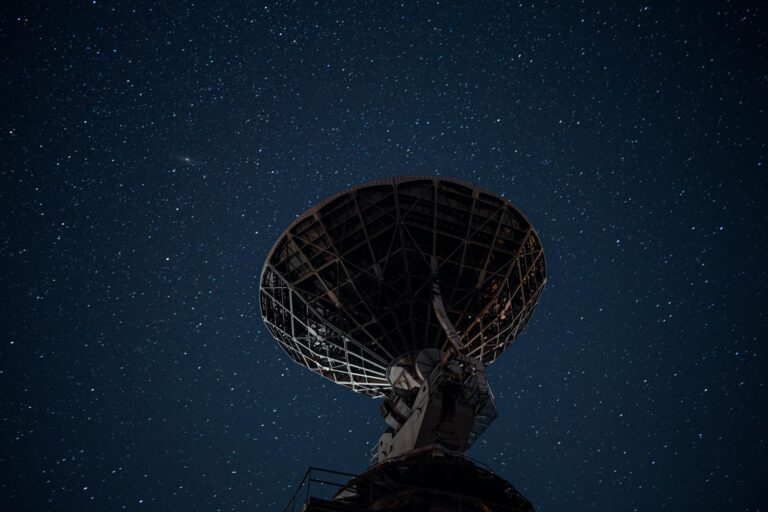Humans have always been curious about what lies beyond our sky. From ancient myths to modern science fiction, the idea of extraterrestrial life has fascinated and inspired us. But what if this isn’t just a fantasy? If intelligent life exists beyond Earth, how do we reach out to them? How can we send a message that cuts across time, space, and culture to make ourselves understood?
These questions form the foundation of interstellar communication—a profound scientific endeavour to bridge the gap between us and potential extraterrestrial civilizations. This blog explores the history, challenges, ethical implications, and future of humanity’s attempts to communicate with alien life.
A Brief History of Interstellar Messaging
The idea of contacting extraterrestrial life isn’t new. Over the years, scientists and enthusiasts have created various ways to send Earth’s “hello” into the depths of space.
The Arecibo Message
Perhaps the most famous interstellar message, the Arecibo Message, was sent on November 16, 1974. Using the Arecibo Observatory in Puerto Rico, scientists broadcasted a 3-minute, binary-coded message toward a star cluster 25,000 light-years away. This message, developed by astrophysicist Frank Drake and others, included information about human DNA, Earth’s position in the solar system, and details about our planet. While a groundbreaking event, it was more a symbolic gesture than a serious attempt at contact, considering the time it would take for the signal to reach its destination—and for any reply to return.
The Pioneer Plaques
On the Pioneer 10 and 11 spacecraft, humanity sent physical messages in the form of engraved plaques. Designed by Carl Sagan and Frank Drake, the plaques featured a depiction of a man and a woman, information about Earth’s location, and our origin in the galaxy. These were the first human-made objects intended to communicate with extraterrestrial life.
The Voyager Golden Records
Launched in 1977 aboard the Voyager 1 and 2 spacecraft, the Golden Records were a bold and optimistic effort to tell our story to anyone—or anything—that might encounter them. These records contained sounds and images representing the diversity of life and culture on Earth. Messages in 55 languages, music ranging from Bach to Chuck Berry, and even a recording of a human heartbeat were included.
The Limitations of These Messages
While these historical efforts were monumental steps, they were not without their limitations. They relied on the assumption that any extraterrestrial being would interpret human-defined symbols, mathematical patterns, and art in similar ways.
The Challenges of Interstellar Communication
Interstellar messaging isn’t as simple as dropping a postcard into space. It comes with unique challenges that make this endeavour both fascinating and incredibly complex.
Vast Distances and Delays
Space is unimaginably vast. For instance, even if our message travels at the speed of light, it could take tens of thousands of years to reach its target—and an equally long time for a response. This delay means interstellar communication is more about taking a leap of faith for future generations than having an immediate dialogue.
The Language Barrier
How do you communicate with a civilization that may have no concept of Earth, humans, or language as we understand it? Scientists often rely on mathematics, believing it to be a universal form of language. However, even seemingly straightforward concepts like basic mathematics or prime numbers could be incomprehensible to an alien brain wired differently from ours.
Noise in Space
Space is full of electromagnetic signals, many of which are naturally occurring. Extraterrestrials receiving our messages would need to differentiate them from the cosmic noise that constantly fills the universe.
Current Efforts in Interstellar Messaging
The quest to reach alien civilizations is far from over. Today, scientists and organizations are continuing to innovate and push the boundaries of what’s possible.
Messaging Extraterrestrial Intelligence (METI)
An extension of the famous SETI (Search for Extraterrestrial Intelligence) program, METI focuses on actively sending messages rather than just listening. METI scientists design and send signals into space with the hope of sparking a response from extraterrestrial civilizations.
Breakthrough Message
Part of Yuri Milner’s Breakthrough Initiatives, Breakthrough Message is a global competition to develop the best interstellar message. Aimed at fostering innovative ways to introduce ourselves to extraterrestrial receivers, this project emphasizes creating content that expresses knowledge of humanity and Earth.
Laser Messaging
One recent advancement is using lasers to send interstellar messages. Unlike radio waves, lasers can transmit data in narrow, focused beams, potentially making communication faster and more efficient.
Constructing the Perfect Message
What should humanity’s interstellar “hello” look like? Scientists often debate how to craft messages that are universally understandable yet meaningful.
Universal Concepts
Mathematics, chemistry, and physics are often chosen as the foundation for interstellar communication. These fields are thought to describe the universe in ways that transcend cultural or biological differences.
Balancing Simplicity and Complexity
A good interstellar message balances simplicity with richness. It needs to be easily decipherable but include enough information to provide insight into humanity’s identity and achievements.
Should We Even Be Sending Messages?
Interestingly, not everyone agrees that sending messages into space is a good idea. Some scientists argue that actively reaching out to extraterrestrials could expose humanity to potential risks, such as hostile civilizations discovering our existence.
Ethical Considerations and Potential Risks
Sending interstellar messages is more than just a scientific endeavour; it’s an action that raises profound ethical questions.
Who Gets to Decide?
Should individual organizations or countries be allowed to represent humanity in interstellar messaging? Many argue that decisions with such global implications require international collaboration and consensus.
The Risk of Contact
What if the civilization that receives our message has motives that conflict with our safety or survival? While the probability of encountering hostile extraterrestrials is low, Carl Sagan famously warned, “It is far better to receive than to send.”
The Role of Diversity
How do we ensure the message we send reflects the diversity of Earth’s cultures, languages, and histories? There’s a risk that interstellar messages might inadvertently represent only a fraction of humanity, creating a distorted view of who we are.
Engaging the Public in Interstellar Messaging
Interstellar communication isn’t just the domain of scientists—it has the potential to unite humanity in a shared purpose.
Citizen Science and Public Participation
Projects like Breakthrough Message often invite public input, allowing individuals to propose and vote on what humanity should say to the stars. This involvement fosters a sense of unity and collective responsibility.
Outreach and Education
Educators and communicators play a crucial role in helping the public understand the importance and implications of interstellar messaging efforts. By sparking curiosity and discussion, they ensure these initiatives remain a vital part of global culture.
Toward a Cosmic Conversation
Communicating with extraterrestrial life might sound like science fiction, but it’s a real scientific effort with profound implications. It forces us to think beyond our planet, our cultures, and even our biological limitations.
Are we ready for the implications of such a conversation? What should we say if someone—or something—replies? These questions may remain unanswered for generations, but they challenge us to reflect on what it means to be human and to prepare for our place in the cosmos.
Join the discussion. Share your thoughts, engage with your community, or get involved in one of the many interstellar messaging projects shaping humanity’s future among the stars.





















0 Comments